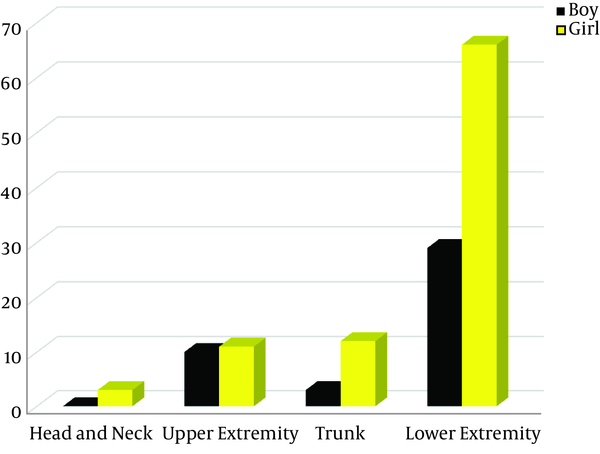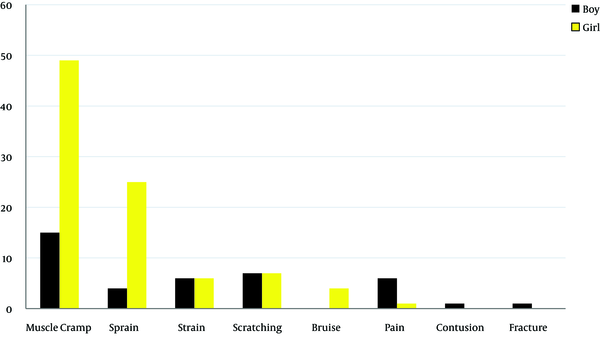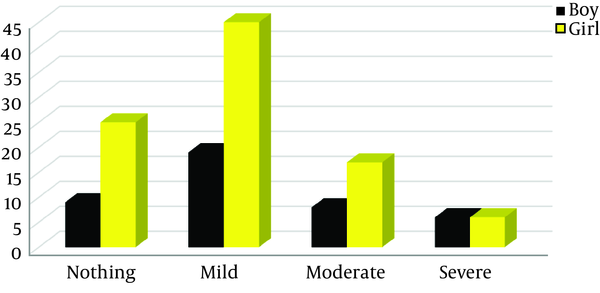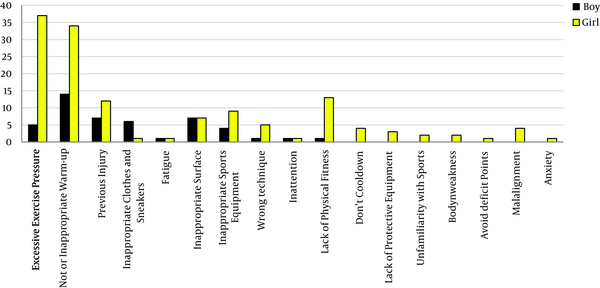1. Background
The major part of the exercise that is closely linked to the health and vitality of the community and it summarizes many of the essential functions of sport are the sport for all (1).
Now with the development and increased participation in exercises and sports will also result in an increase in exercise-related injuries (2). To the ordinary observer, athletics injury may appear to be accident-random. However, many factors play a role before the injury event (3). Also, monitoring of occupational and sports injuries are a precondition for the protection and health of athletic, which is related to critical studies.
Among the important epidemiological indicators that considered by the researchers, are the incidence, location, type, and severity of the injury (3-5). Determining the type and place of damage help coaches and researchers to consider bio-mechanical and muscular strength factors and, if there are dangers damage to sensitive areas, seek to improve techniques or protective equipment (6, 7).
The Olympiad of universities and schools students promote sports and taking part in group activities in future community of the society are held in different titles in the country. Ebrahimi et al. (8) studied the frequency of sport’s injuries and its related causes in male students that taking part in Olympiad in 2010 in Khorasan Razavi.
2. Objectives
In the same way, sports for all competitions were discussed by the Ministry of Science, Research, and Technology at the university level in three years ago. This year (2017), the first sport for all Olympiad for female and male students of universities and institutes with higher education was held by Tehran University. The results of this study will help current knowledge about the dangers of injury during the tournament, especially the sport for all and some advice for the future. Finally, the study wants to examine the epidemiology of sports injuries during the 1st National Sport for all Olympiad.
3. Methods
This research is the descriptive-cross-sectional and a prospective study among girls and boys students with an average age (21.93 ± 2.28) and body mass index (21.09 ± 2.71) in six sports, Targeted Soccer Shooting, basketball shooting, Seven Stone, frisbee, Jump Rope, and physical fitness (Table 1). After coordinating with Physical Education Deputy of Tehran University, the director of Physical Education of the Ministry of Science and Technology, the University of Tehran Health Management was conducted the research. The study population consisted of 548 female students and 575 male students that were participating in the first National Olympiad Sport in Tehran (July and August 2017). The statistical sample of this study included students, who had a musculoskeletal complaint saw competitions' physician and received the medical care. Also, they were selected after signing informed consent forms. The subjects were also ensured of the confidentiality of their information and their right to withdraw from the study at their own discretion.
| Sex | Mean ± SD | Minimum | Maximum |
|---|---|---|---|
| Male | |||
| Age, y | 21.76 ± 2.34 | 18 | 31 |
| Weight, kg | 72.33 ± 9.44 | 57 | 96 |
| Height, cm | 178.92 ± 5.78 | 168 | 192 |
| BMI, Kg/m2 | 22.57 ± 2.56 | 18.31 | 28.36 |
| Female | |||
| Age, y | 22.01 ± 2.26 | 18 | 32 |
| Weight, kg | 55.18 ± 7.93 | 40 | 80 |
| Height, cm | 164.36 ± 5.31 | 175 | 152 |
| BMI, Kg/m2 | 20.39 ± 2.50 | 14.88 | 30.11 |
Demographic Information
The incidence of injury was calculated with this formula (9):
The information was collected through an injury report form that is produced by sports medicine Doctor opinions and other related research, including information such as parts of injury, type of injury, cause of injury and the severity of the injury.
In the injured areas, 40 areas in four sections of the head and neck, upper extremity, trunk, and lower extremity were examined. About 12 injuries were investigated in the type of injuries. All information about the type of injury, the severity of the injury, the part of injury recorded by Olympiad’s physician and researcher. The severity is defined as the number of days that student is far away from the sport until they recovered. Also, classified in 4 groups (4). The cause of the injury is also expressed by the participants. In this study, descriptive statistics in terms of numbers, tables and charts were used to express the research findings and compare them. Data analysis was done using SPSS software version 18, the chi-square test at a significant level of less than 0.05 and the Fisher test is used in some cases instead of Xi.
4. Results
4.1. Incidence
In total, the boys and girls suffered 136 injuries (19 recurrent injuries) during the 6 days of the Olympics (three days of girls and three of boys) in 190 competitions in 6 sports. The 1123 players were at risk of injury; as a result, the incidence of injury in exposed players was equal to 0.12 or, in the other word, 121.1 per 1,000 athletes. In general, the incidence of injury in girls was higher than boys. The incidence of injury in girls was 169. 7 (194.4, 140: 95% CI) and for boys was 74.78 (90, 50: 95 Cl%) in 1,000 athletes-exposure.
4.2. Anatomical Region
In general, the majority of injuries were related to the lower extremities, upper extremities, trunk and the lowest amount of head and neck injuries, respectively. The results of the study showed that there was a significant difference between the number of injuries in different anatomical regions of boys (χ2 = 30.38, P = 0.011). Also, there was a significant difference between the incidences of injury in different anatomical regions of the girl’s body (P = 0.0001, χ2 = 125.04). Fisher test results showed no significant difference between the girls and boys in different anatomical regions (P > 0.05) (Figures 1 and 2).
4.3. Type of Injury
There was a significant difference between the types of injury in boys (χ2 = 30.22, P = 0.01) and girls (χ2 = 142.51, P = 0.01). The Fisher test results showed a significant difference between the type of injury of girls and boys (phi = 0.46) (Figure 3).
4.4. Severity of Injury
There was a significant difference between the severity of injury in boys (χ2 = 9.61, P = 0.01) and girls (χ2 = 34.95, P = 0.01). Fisher test results showed no significant difference between girls and boys in the severity of injury (P > 0.05) (Figure 4).
The severity of injuries in this study according to the National Atomic Disorders Injury system (NARIS) in the United States, based on time loss of exercise, was classified into three categories: mild (1 to 7 days), moderate (8 to 21 days) and severe (over 21 days) (4). Also, nothing means they did not need time loss.
4.5. Girls and Boys Cause of Injury
According to the participant athletes, the most common cause of injuries in boys were not or unsuitable warming up (29.78%) and previous injuries (14.89%) and the most causes of injuries in girls were excessive exercises pressure (27%), unsuitable warming up (24.81%) and lack of physical fitness (9.48%) (Figure 5).
5. Discussion
This study examined epidemiological sports injury at the 1st National Olympiad Sport for all for the Universities and Higher Education Institutions. Compared with the injury rate to other studies, Yen et al. (10) reported an injury rate of 0.15 during the three days of the Frisbee academic championship, which is close to the results of this study. However, the injury rate of Harvard Frisbee players per season (0.012 or 12.64 per 1,000 exposed) is lower than the present study (11). This result may be due to the fact that two studies (Frisbee and this Olympiad) concerned only competition time. But the Harvard study is related to training season, and people in the competition are more likely to be injured than in a training season (12). Also, it can be said that due to the sensitivity and higher intensity of the movements in the competition, the probability of injury is higher. One of the other causes is the type of study. In prospective studies, the magnitude of injury is more than retrospective studies. Because injuries, that may not be regarded as injuries in the athlete’s point of view, or when recording a retrospective injury, because of mild neglect to remember, they are enrolled in prospective studies. But, they are recorded as retrospective studies. Also, our definition of injury was not included avoiding competition and considering everything that needed medical attention. In this case, even the smallest musculoskeletal complaint was considered. Overall, the unknown Olympiad’s sports, the first experience of the tournament, and the participation in several sports by any individual caused a high incidence of injury.
Also, the incidence of injury in girls was higher than boys. Despite the higher rate of injury in girls. There was no difference in the incidence of injury between girls and boys (11, 13). On the other hand, there were studies that reported high injuries in boys (14). Yen et al. (10) and Laoruengthana et al. (15), reported more injuries to boys. Laoruengthana et al. (15) stated that fewer girls' participation in full-contact-sports resulted in fewer rates of injury (10, 15). According to the Olympiad’s regulations, universities were asked to select non-athletes to take part in the Olympiad. As a result, the majority injury cause of girls was being the non-athlete toward boys (the average number of physical activities in girls was 2 hours per week, and the boys were 7 hours). Also, it seems that some sports, such as Targeted Soccer Shoots, are not suitable for girls with this level of physical fitness. Because most of the boys have experienced and familiar with soccer during their lives.
Regarding the injury region, most injuries were related to the lower extremities in the thighs, ankles, shins, and knees, respectively. The fewer lower extremity injuries have been reported in many studies of the Championships and recreational sports (16-18). In boys, most injuries were related to shins and knees, and then in thighs and elbows. In girls, most injuries were in the thighs, ankles, and shins. The results of the research by Swedler et al. (11) and Marfleet (19) were according to the results of this study. Swedler et al. (11) reported most injuries in the ankles, knees, thighs, and Marfleet (19) stated thighs, knees, ankles and shins, respectively. In 2007 in the college Frisbee championship, most injuries were related to the lower extremity and ankles injuries that consistent with this study and in girls more than boys (17% vs. 11%) (10). In Al-Shaqsi’s (20) research, similar to the present study, knees injuries were reported as one of the most common injuries in boys, and the back injuries were reported as the most common place among girls, and in the Olympiad, the waist injuries in girls were higher than of boys. In the final conclusion, overcoming lower extremity injuries to other areas of the body in this Olympiad, due to the overuse and repetitive stresses of running and jumping in these style of exercises in this Olympiad, it seems normal.
The most common types of injury in boys were muscle cramp, scratching, and abrasion, and in girls, they were muscle cramp and sprain. Our findings coincided with Yen, reported muscle cramp was highest in both genders (10). But according to Sweedler, sprain occurred more in boys (11). There has been little research on sports injury in Olympiads. In this study, engaging athletes in over one competition in a short time and the nature of the sport (requiring maximum speed and having shearing movements), not only exposed athletes in muscle cramp but also causes overuse injury, ankle sprain, and strain.
In the scratches and abrasions, the small number of athletes referred to the physician, give an incorrect estimate. Because it was more than this number and the cause of a few referrals to the physician was due to them did not require interventions, and this was because of inappropriate and hazard equipment. In sum, the type of injuries was mild and soft tissue damages. This suggests that these injuries are not as worry as hard tissue damages, but they need more attention because of the high incidence of injuries.
The highest severity of injuries in boys and girls was mild, nothing and least severe. In boys students, most of the injuries were mild (67.2%) and the least severe (9.9%) (21). Perhaps the higher number of mild injuries was due to the fact that at many injuries, such as cramp, the athletes continued to practice and practice even at rest, and heavily damaged injury significantly. If the physician considers it necessary for the individual to have one or two days rest before starting the exercise and returning fully. According to the athlete's opinion, the most common causes of injuries in boys were not or inappropriate warm-up and recurrent injuries, and in girls the excessive exercises pressure and not or inappropriate warm-up. Our findings in this section were similar to other studies (10, 19). Studies have proven that warm-up increases the athlete’s body temperature, can significantly reduce injury, not just stretching (22). Since warming was one of the major causes of injury, it can be concluded that many of those who said they were warmed up and injured, did not raise their body temperatures.
In Olympiad, every team was practicing throughout the day. Since over-training is an example of fatigue, it occurred when activity is not accompanied by enough rest. Fatigue reduced muscular force transmission and decreased contraction speed, increased passive tissue force, and altered the feedback of the nervous system and reduced articular stability (23). Girls also often suffered physical exhaustion during this period and weeks before the tournament because most of them were not an athlete, they expressed excessive exercise as their main cause. Contrary to these conditions, most boys often had regular physical activity during the week, they expressed the previous injuries in sports or previous events as their causes. The remaining deficiencies in physical fitness and proprioception or change in the patterns of motion after previous injuries will expose the person to further damage (24). In this research, 3 boys and 2 girls were not informed due to a lack of access. Due to the lack of enough physicians on the match, lost injuries that occur during the competition and the athlete did not refer to the physician for any reason, also we considered the practice and match injuries in these six days.
The girl’s incidence rate was more than boys, also Thighs were the most injured region in girls, and shins and knees were the most injured in boys. The most severe type of injuries was mild. It is suggested that in the coming year, Olympiad’s injuries, such as the sports injuries record system be collected to obtain more accurate information and, with the number of more specialists, examined other aspects of epidemiology in order to identify these national Olympiads. The least risk factors were to achieved their primary goal of creating vitality, teamwork and participation of students in sport. There weren’t enough doctor in Olympiad, so we couldn’t record injuries that happened exactly in competitions. Also, practice and match injuries collected, and we couldn’t separate them. We didn’t analyze the sports equipment, but they can be causes of injury in this Olympiad. So they could be more equipped in future events.
5.1. Conclusions
In general, the prevalence of injuries is significant due to medical considerations at the General Sports Olympiad due to the lack of physical fitness and participation of most people in more than one field of sport compared to other studies. In addition, girls were more likely to be harmed than boys. Most of the injuries of girls were in the thighs and boys in the legs and knees. Most of the Olympiad’s injuries were mild and muscle cramp, and after that, sprain and scratch and abrasion occurred. Excessive pressure, not a warming-up and previous injury were causes of injury from the participants’ opinion.





